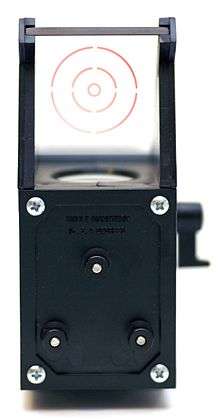Finderscope



A finderscope is an aiming device used in astronomy, typically a small auxiliary telescope mounted on the main astronomical telescope along the same line of sight. The finderscope usually has a smaller magnification than the main telescope, providing a much larger field of view, useful for manually aiming (also called "slewing") a telescope and locating a desired astronomical object. Some finderscopes have crosshairs to aid in accurately pointing the telescope system at a target.
Function and Design
Finderscopes contain mechanisms to properly align them with the main telescope's line of sight. Accomplishing this alignment varies based on the design of the finderscope and its mount: usually on amateur telescopes it is done by three or six adjustment screws.
Finderscopes usually come with a designation of the form A×B, where A is the magnification and B is the aperture of the finderscope's objective lens in millimeters; for example, a 6×30 finderscope means a finderscope with a 30 mm objective and a magnification of 6×. This designation is in the same format used by most binoculars.[1]
A 6×30 finderscope is typically considered the minimum useful size for a magnifying finderscope on an amateur telescope, and an 8×50 or larger finderscope is preferred for more accurate aiming.[2]
Most finderscopes have one of three viewing orientations:
| Type | Eyepiece mount | Image orientation |
|---|---|---|
| Standard | Straight through | Upside down and reversed (i.e. rotated 180 degrees) |
| Right-angle | 90 degrees | Backwards (mirror-image) |
| RACI (Right-angle correct-image) | 90 degrees | Correct |
Reflex Sights
Another type of finder commonly found on amateur telescopes is known as a reflector (reflex) sight. This non-magnifying sight (technically not a "scope") uses a type of beam splitter to "reflect" a reticle generated by collimating optics into the users field of view. The view of the sky seen through the sight is just what can be seen with the naked eye with an illuminated crosshair or dot seeming to float in space at infinity. These crosshairs are generally illuminated by a small LED. Reflex sights are most useful for locating bright objects visible to the naked eye such as stars, planets, or nebulae. Since the sight uses a beam splitter "window", instead of an optical telescope with the ability to gather light, objects dimmer than the naked eye limit can not be seen through it. The lack of an optical telescope's magnification can make it harder to discern the difference between objects, such as stars and small angular size nebulae. They can also be used when finding dimmer objects by using the object's known position relative to brighter objects as a reference.
See also
References
- ↑ "How to Select the Right Binocular". Meade Instruments Corporation. Retrieved 15 November 2013.
- ↑ "The Backyard Astronomer's Guide", by Terence Dickinson and Alan Dyer.